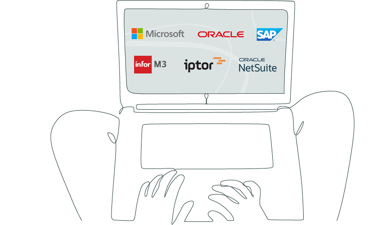The benefits of integrating ERP with AP automation
Hear what's covered in this article:
In today's fast-paced business environment, efficiency and strategic advantages are paramount. Two key players in this arena are Accounts Payable (AP) Automation and Enterprise Resource Planning (ERP) systems. Individually, they streamline business operations; together, they can transform your business.
What is AP automation?
AP automation is a technology that streamlines traditionally manual and repetitive tasks, such as invoice intake, GL coding, and approval routing, across the accounts payable lifecycle. It reduces processing time and errors, increases visibility, and allows finance professionals to focus on strategic initiatives.


What is an ERP system?
Enterprise Resource Planning (ERP) systems serve as centralized software platforms that manage a business’s core operations: finance, supply chain, procurement, HR, and more. By providing a single source of truth for data, ERP platforms improve decision-making and transparency.
Why integration matters
While AP automation and ERP systems deliver individual value, their integration unlocks transformative capabilities. It connects invoice capture, approval workflows, and payment execution directly with the ERP’s financial and supplier records, ensuring real-time data flow, fewer touchpoints, and significantly reduced risk.
For an example of integration at scale, see the Fluiconnecto case study, which details how centralized AP automation connected seamlessly with multiple ERPs across the group.
Core benefits of integrating
ERP and AP automation
Enhanced operational efficiency
One of the most significant benefits of integrating ERP with AP automation is improved operational efficiency. Manual data entry is significantly reduced, invoice intake is digitized through tools like OCR, and intelligent workflow routing automates approvals. This not only speeds up invoice processing but also reduces late payments and improves team productivity. AP teams can focus on strategic initiatives instead of chasing paper or resolving exceptions.
Automated matching of invoices with POs and receipts ensures accuracy and eliminates redundancies. Real-time alerts and approvals help eliminate bottlenecks, especially in complex or high-volume environments.
Improved financial visibility
When ERP and AP systems are integrated, finance teams gain real-time access to end-to-end invoice lifecycle data, ranging from invoice intake through to payment. With a centralized source of truth, they can monitor outstanding liabilities, manage accruals, and forecast working capital more accurately.
This visibility also promotes stronger interdepartmental collaboration. Global teams can work from shared data and dashboards, improving compliance readiness and accelerating month-end close.
Stronger compliance and risk management
ERP and AP automation integration ensures all activities are recorded in a unified audit trail. Access controls and approval hierarchies are enforced automatically, reducing the risk of manual overrides or unauthorized changes.
Additionally, advanced AP solutions now leverage artificial intelligence to detect abnormal patterns, duplicate submissions, or vendor manipulation. These tools can flag suspicious behavior in real-time, filling the gaps static ERP systems can’t catch on their own.
Explore how Medius uses AI to combat deepfake and invoice fraud across connected systems.
Cost savings
Automation reduces operational costs in multiple ways, from minimizing paper use to reducing time spent resolving invoice exceptions. Early payment discounts are easier to capture, and late fees are reduced thanks to faster processing cycles.
Further cost efficiency is achieved through role-based access and separation of tasks. For some companies, integrated AP automation means fewer ERP seat licenses are needed, as many approval and processing tasks shift outside the ERP environment.
Scalability for growth
As businesses grow, so does their invoice volume and complexity. Manual processes can't scale at the same pace without added cost or headcount. ERP and AP automation integration makes it easier to onboard new vendors, handle diverse tax rules, and process thousands of invoices without disruption.
Whether your business is entering new regions or expanding procurement categories, integrated automation ensures finance operations stay agile.
Better supplier relationships
Late payments damage supplier trust and can put production timelines at risk. Integrated systems support prompt, accurate payments by ensuring invoices are processed efficiently and exceptions are flagged early.
This leads to better supplier communication, improved payment terms, and stronger long-term relationships.
From days to minutes:
how AI strengthens supplier relationships
See how Samuel, Son & Co. dramatically improved their vendor communications, thanks to AI. By building on their existing use of Medius AP automation with AI-powered Supplier Conversations, they slashed response times from days to minutes, freeing their AP team from constant inquiries and strengthening valuable supplier partnerships.
How does ERP and AP automation integration work?
The integration of AP and ERP systems allows your ERP to serve as a unified source of transaction data across your organization, offering transparency across the procure-to-pay process. This integration minimizes human error, reduces late or missed payments, enhances invoice verification and reconciliation, fortifies supplier relationships, and provides support for payment systems.
The key to successful integration is seamless data transfer between the AP automation system and the ERP. The method of integration typically depends on whether the ERP system is cloud-based or on-premise. Cloud-based platforms support application programming interface (API) integration, which AP teams can easily implement without the need for extensive IT support. In contrast, on-premise ERP systems usually require file integration using customized file templates to import or export data.
Here's how the key touchpoints align:
Invoices are automatically scanned and entered into a centralized database. All invoice details and line-item data are captured, GL coded, and validated.
Based on customizable rules, invoices are automatically routed to the appropriate employee for review and approval.
Once invoices are entered and verified, they are automatically uploaded to the ERP’s AP ledger.
Transaction data, communication history, and approval statuses are automatically shared with payment systems, facilitating accurate and timely payment execution.
The AP platform supplies accurate invoice and transaction data to the ERP, enabling real-time invoice and payment reconciliation.
Both systems synchronize and enforce internal controls, centralize data, and maintain a complete AP audit trail with enforced separation of duties.
Real-time transaction data, approval status, and insights into AP workflows are shared with the ERP to provide actionable business intelligence.
Every action, approval, edit, exception, is logged across both platforms, supporting audit readiness and internal oversight.
By automating and optimizing these processes, the integration of AP automation and ERP helps businesses achieve a level of process efficiency that far surpasses manual methods.
Want to see how centralized payments benefit from ERP integration? Read more about enabling payments via ERP.
Integrate your ERP with Medius
The strategic value of integrating AP Automation with ERP systems cannot be overstated. It is a crucial step in the journey towards digital transformation and operational excellence. By embracing this integration, businesses can streamline their financial processes, improve efficiency, and gain a competitive edge. With Medius, this transformation is within reach.








